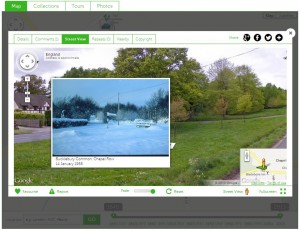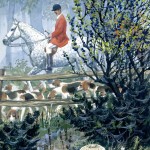Since we’ve gone a bit quiet about our progress on the cataloguing front recently, I thought I would let you know how we’ve been getting on over the past month or so. We have slowed down somewhat as other aspects of the project start to pick up pace, but our current total sits at just above 4,500 records. Initially progressing chronologically, we have worked through the records from 1951, when the Museum was founded, to 1954 in full, and have also completed parts of 1955 and 1956. More recently, though, our focus has shifted to other areas of the collection. Greta has been working her way through the Museum’s collection of baskets (about which I think she is planning a separate post), whilst Danielle and I have been completing the objects in the collection from the Berkshire village of Bucklebury, in preparation for our work with Historypin.
There are between 300 and 350 objects from Bucklebury in the collection. It is hard to give a more precise figure, because more information becomes available as we work our way through the records. We have just one object record file for objects from the Hedges Foundry, for example, but this actually relates to 26 individual wooden patterns. In addition to the objects from the Hedges Foundry, which was situated in Bucklebury Village, much of the rest of the material comes from the bowl turner George Lailey and the handle maker Harry Wells.
I spoke in a previous post, Cataloguing ‘place’, about our geographical hierarchy, which is largely based on the Getty Thesaurus of Geographic Names, with a few alterations and additions. In the case of the Bucklebury material, we have decided to add still further levels of detail into our hierarchy. This reflects the fact that we are in a sense using Bucklebury as a trial area, exploring some of the ways in which this approach can be implemented in collaboration with local communities, and we want to make our hierarchy as relevant as possible to their understanding of ‘place’ in Bucklebury. Of course, in order to do this, we had to get a good grip on how ‘Bucklebury’ works, which was one of the main reasons for our visit a few weeks ago.

The church gate lantern in Bucklebury Village, made at the Foundry
When we first met the Bucklebury History Group, I naïvely asked ‘So, how exactly is Bucklebury laid out?’ My question was met with knowing smiles. We had a look at a huge map of the parish, and immediately saw part of the problem, which Danielle also described in her earlier post, The Bucklebury Experience. Bucklebury Village itself, situated on the banks of the River Pang, is actually quite small. Upper Bucklebury, where many of the more modern houses are situated, is up to two miles away down narrow country lanes, in the middle of the Common. A further hamlet, Chapel Row, sits to the eastern edge of the Lower Common. A smaller hamlet, The Slade, sits on the western edge of the Upper Common. And then, dotted in between, are other clusters of houses, each with distinct names and identities, but all considered to be a part of ‘Bucklebury’. These include Turner’s Green, where Lailey’s workshop was situated, Byles Green, Miles’s Green, Workhouse Green, and the grandly named hamlet of ‘Scotland’.
Knowing this, it seemed insufficient to give ‘Bucklebury’ just one listing in the hierarchy. Besides, the given latitude and longitude on the Getty Thesaurus was situated in a somewhat obscure spot in a field in the parish, which hardly seemed to reflect the complexity of the village’s geography. Our tour of Bucklebury was incredibly useful. Physically walking and driving around and between the places in Bucklebury gave us a far better understanding of the place than simply looking at a map. Obviously this approach is impossible on a larger scale, but for the purposes of our work with the Bucklebury History Group and Historypin, it was invaluable. The hierarchy we have come up with will hopefully enable the collections to be pinned to the map with as much accuracy as possible, reflecting the level of information we have about places in Bucklebury.

One of two ancient fish ponds on the Lower Common
The broadest ‘Bucklebury’ thesaurus term in our hierarchy relates to everything within the parish boundary. At a lower level, we list the larger distinct places: ‘Bucklebury Village [Bucklebury]’, ‘Chapel Row [Bucklebury]’, ‘Bucklebury Common [Bucklebury]’ and ‘Upper Bucklebury [Bucklebury]’. Some hamlets, such as ‘Bushnells Green [Bucklebury]’ are also listed at this level because they are isolated within the parish, but other hamlets, such as Turner’s Green are first linked to bigger places with which they are associated. For example, Turner’s Green is situated on the Common, so is listed as ‘Turner’s Green [Bucklebury Common [Bucklebury]]’. The essence of our approach is to include as much detail as possible, so that we can find the precise latitude and longitude for distinct villages, hamlets, and even houses, which will ultimately enable the collections to be mapped as accurately as possible to the places with which they are associated. It does feel as though we might have picked the most complicated village in England to use as a case study, but perhaps I am just expecting (or even hoping for) a logical simplicity that simply doesn’t reflect the realities of place.










